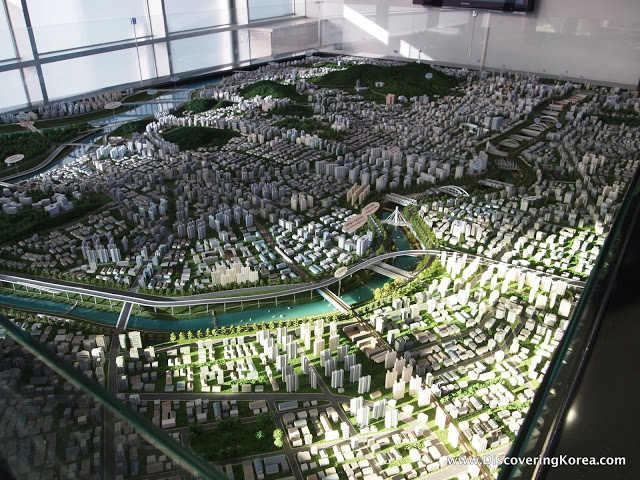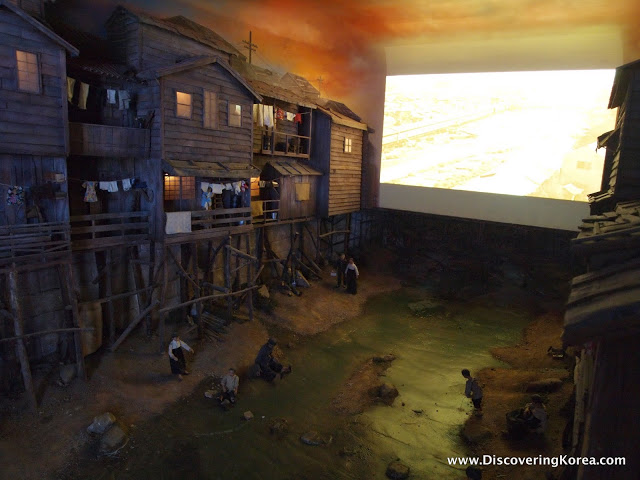Operated by the Seoul Museum of History, the Cheonggyecheon Museum (청계천박물관) is located on the south bank of the Cheonggyecheon stream’s (청계천) eastern boundary, just before it converges with the Jungnangcheon (중낭천) on its way into the Hangang river.

The Cheonggyecheon Museum was opened on September 26, 2005, just five days before the “clear stream” itself was re-introduced to the public.
The remarkable transformation of the Cheonggyecheon stream – from a thriving stream, to a polluted cesspool, to an elevated expressway, is certainly a compelling story to be told.
From the outside, the Cheonggyecheon Museum’s long shape actually resembles a stream, due to a wide panel of blue glass that seems almost like a reflection of the water below.
Once inside, the 4,200 square meters of exhibition space is organized into four levels. I say “levels” rather than floors because after riding an escalator to the top, visitors work their way back down via four long ramps featuring 12 different exhibits.

The upper levels start with a glimpse of the Cheonggyecheon stream at its worst, when waste from streamside shantytowns turned what was once a pristine oasis into a stagnant reservoir of untreated sewage.
What followed was the total destruction of the waterway, when the shanties were cleared in the 1960s and an elevated expressway paved over the streambed.
It all looks pretty bleak until you reach the section’s happy ending, which is a look at how the 380 billion won restoration project was conceived and executed.
The next section focuses on the importance of the stream during Korea’s Joseon Dynasty. In one part, four of the royal era’s most famous kings – Taejong, Sejong, Yeongjo and Jeongjo – talk about how the stream impacted life in their capital over 500 years.

Both a source of fresh water for a growing population, and a source of frustration due to frequent floods, it’s clear that the Cheonggyecheon stream helped shape Seoul’s history.
Anyone who’s visited the Cheonggyecheon stream knows that its many bridges are a prominent feature. There are 22 of them in all, and part of the Cheonggyecheon Museum is dedicated to retelling some of those old bridges’ stories.
For example, much of the stream’s very first bridge – Gwangtonggyo – can still be traversed. This is all the more remarkable since its original earthen form was constructed back in 1410!
In addition to the permanent collection, the Cheonggyecheon Museum also hosts performances and lectures, as well as special exhibitions.

This spring, “Old Seoul through Foreign Eyes” unveils the “Gyeongseong 1939” video to the general public for the first time.
Referring to Seoul’s name during the Japanese colonial period, the video was recorded by the colonial railway authority, and offers a stunning glimpse into pre-war Seoul when electric street cars took locals donning tall hats and bright white hanbok clothing to and from stately colonial buildings.
Finally, a visit to the Cheonggyecheon Museum shouldn’t neglect the outdoor viewing area, which affords great views of the stream and surroundings.
As expected, a revitalized Cheonggyecheon stream has spawned a construction boom along its banks.
So take a look around, because it’s a fair bet that this historically industrial part of the city won’t be that way much longer.
For Your Information…
| Open: | 09:00-21:00 (Tue-Fri), 09:00-19:00 (Sat-Sun, Holidays), Closes 18:00 on weekends Nov-Feb, Closed Mondays |
| Admission Price: | Free |
| Address: | Seoul Seongdong-gu Majang-dong 527-4 |
| Directions: | Yongdu Station (#211-3) on Line 2′s spur line, Exit 5 |
| Phone: | 02-2286-3410 |
| Website: | Official Site |
About Matt Kelley
Matt Kelly is native of the US Pacific Northwest and is half-Korean by ethnicity. He lived in Korea for five years and has written hundreds of travel guides for Wallpaper, TimeOut, the Boston Globe and Seoul Magazine and was a host for several different variety shows on Korean radio and television.
